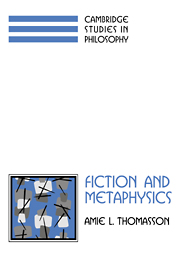Book contents
- Frontmatter
- Contents
- Acknowledgments
- Introduction: From Fiction Into Metaphysics
- Part One The Artifactual Theory of Fiction
- Part Two Ontological decisions
- Foreword
- 6 Fiction and experience
- 7 Fiction and language
- 8 Ontology and categorization
- 9 Perils of false parsimony
- 10 Ontology for a varied world
- Notes
- Bibliography
- Index
10 - Ontology for a varied world
Published online by Cambridge University Press: 23 September 2009
- Frontmatter
- Contents
- Acknowledgments
- Introduction: From Fiction Into Metaphysics
- Part One The Artifactual Theory of Fiction
- Part Two Ontological decisions
- Foreword
- 6 Fiction and experience
- 7 Fiction and language
- 8 Ontology and categorization
- 9 Perils of false parsimony
- 10 Ontology for a varied world
- Notes
- Bibliography
- Index
Summary
It is time to turn to the second ontological task, offering an assessment of what there is. We can already draw some conclusions from the ways in which our categories are drawn out and from their relations to each other. First, if we take our ordinary beliefs and practices at face value, then it seems that a great proportion of entities including scientific theories, works of art, and cultural artifacts do not fit easily into traditional categories such as the real and the ideal, the material and the mental. Thus we either have to show that we can eliminate or reduce all of these to objects lying in the traditional categories or postulate a richer ontology able to account for such variation.
Second, because of the close relations among the categories, questions of whether or not to postulate many sorts of entity hang together. Thus the stakes are high, for despite the apparent variety of entities, principled decisions to eliminate one type of entity may have wide-ranging consequences. For example, consistency requires that if you eliminate the supporting entities such as mental states, you eliminate all of those cultural objects, behaviors, and institutions that depend on intentionality. If you eliminate abstract objects on principle, you find poems and sonatas, laws and theories disappear along with your rejected universals. And if you eliminate fictional objects but keep stories or other abstract entities depending on mental states, you are left with a theory that has only false parsimony.
- Type
- Chapter
- Information
- Fiction and Metaphysics , pp. 146 - 153Publisher: Cambridge University PressPrint publication year: 1998



